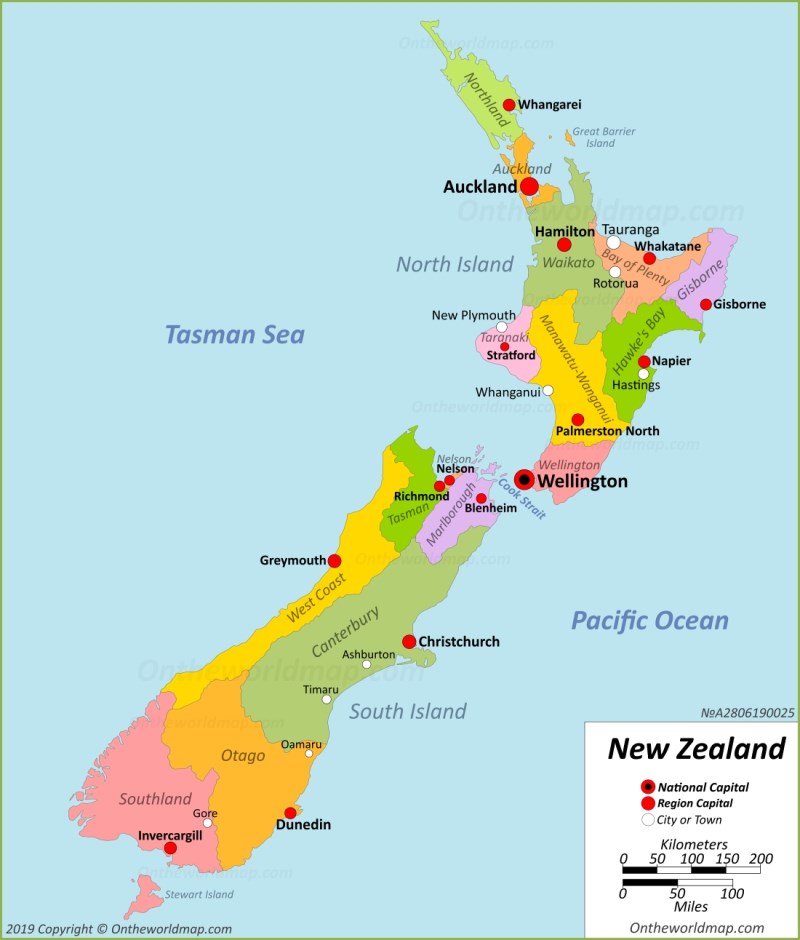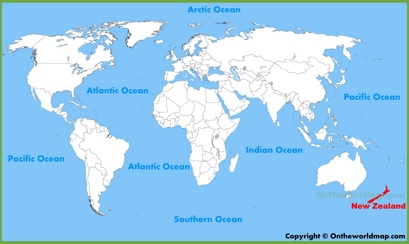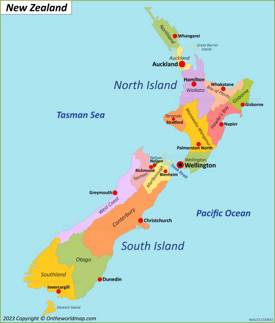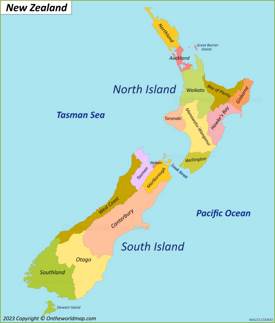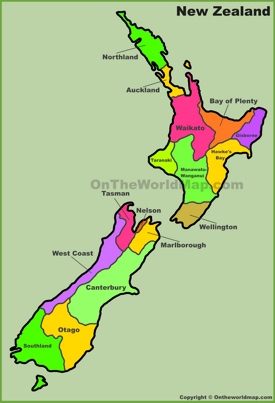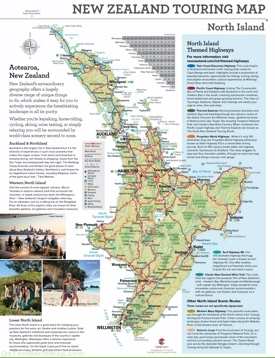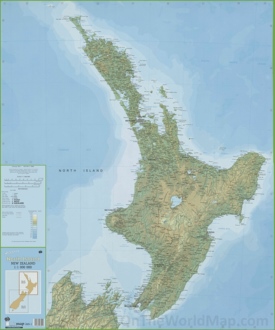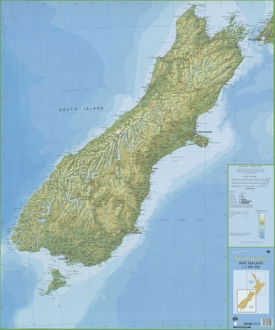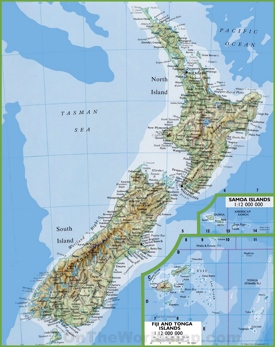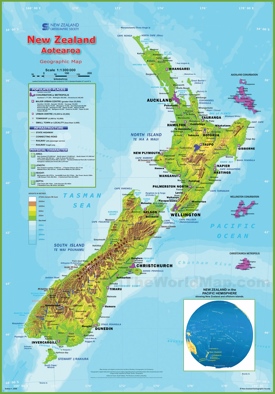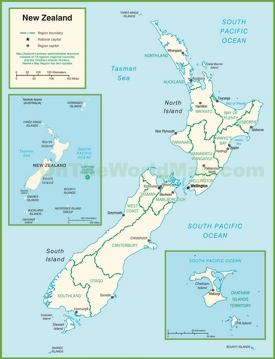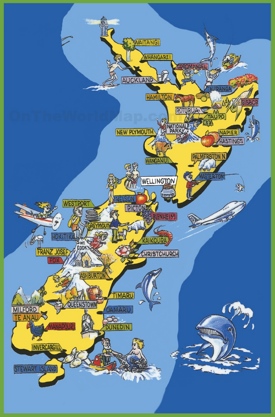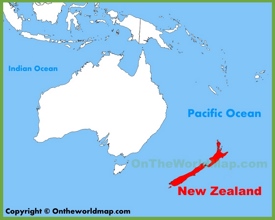New Zealand Map
Description:
This map shows islands, regions, region capitals, and major cities in New Zealand.
Size: 1100x1292px / 244 Kb
Author: Ontheworldmap.com
You may download, print or use the above map for educational, personal and non-commercial purposes. Attribution is required. For any website, blog, scientific research or e-book, you must place a hyperlink (to this page) with an attribution next to the image used.
Online Map of New Zealand
About New Zealand
New Zealand, a sovereign island country, lies in the southwestern Pacific Ocean, approximately 1,200 miles (2,000 kilometers) east of Australia. The country consists of two main islands - the North Island (Te Ika-a-Māui) and the South Island (Te Waipounamu) - along with approximately 600 smaller islands. New Zealand encompasses a total area of 101,660 square miles (263,310 square kilometers).
The country's population reaches approximately 5.45 million people (February 2025 estimate), with over 85% residing in urban areas. Wellington serves as the capital city, while Auckland, the largest city, houses nearly one-third of the total population. Other significant urban centers include Christchurch, Hamilton, and Dunedin. English and Te Reo Māori function as official languages, with New Zealand Sign Language as the third official language.
New Zealand maintains a highly developed, market-based economy, ranking among the world's most prosperous nations. The country's economic strengths include agriculture, particularly dairy exports, wool, and wine production. Tourism, technology, and film production contribute significantly to the economy. The nation emphasizes renewable energy, with over 80% of electricity generation coming from renewable sources.
The geography exhibits remarkable diversity, featuring mountains, fjords, volcanoes, and extensive coastlines. The Southern Alps, running through the South Island, include Mount Cook (Aoraki), the highest peak at 12,218 feet (3,724 meters). The North Island contains active geothermal areas and volcanoes, particularly in the Taupo Volcanic Zone.
Tourism represents a major economic sector, attracting millions of visitors annually to its natural wonders and adventure activities. Popular destinations include Milford Sound, with its dramatic fjords and waterfalls; Rotorua's geothermal attractions; and Queenstown, known as the adventure capital of the world. The country gained additional fame as the filming location for "The Lord of the Rings" and "The Hobbit" trilogies, drawing film tourism.
The climate varies from subtropical in the far north to cool temperate in the south, with significant rainfall throughout the year. The country's isolation has resulted in unique biodiversity, including many endemic species like the kiwi bird and kakapo parrot. Conservation efforts protect numerous national parks and marine reserves, though introduced species pose ongoing challenges to native wildlife. New Zealand's commitment to environmental protection reflects in its nuclear-free status and ambitious climate change policies.
The Facts:| Capital: | Wellington |
| Area: | 101,660 sq mi (263,310 sq km) |
| Population: | ~ 5,459,450 (February 2025 estimate)[1] |
| Official language: | English, Māori, NZ Sign Language |
| Religion: | 48.2% no religion 36.5% Christianity 2.7% Hinduism 1.3% Islam 1.1% Buddhism 1.3% Māori religions 1.9% other |
| Ethnic groups: | 70.2% European 16.5% Māori 15.1% Asian 8.1% Pacific peoples 1.5% ME/LA/African |
| Currency: | New Zealand dollar ($) (NZD) |
| Driving side: | left |
| Calling code: | +64 |
| Internet TLD: | .nz |
| Time zone: | UTC+12 (NZST) Summer (DST) UTC+13 (NZDT) |
| Official government website: | www.govt.nz |
| Official tourism website: | www.newzealand.com |
Google Map of New Zealand
List of Largest Cities in New Zealand by Population
- Auckland ( ~ 1,480,000)
- Christchurch ( ~ 390,000)
- Wellington ( ~ 220,000)
- Hamilton ( ~ 190,000)
- Tauranga ( ~ 165,000)
- Lower Hutt ( ~ 115,000)
- Dunedin ( ~ 108,000)
- Palmerston North ( ~ 83,000)
- Napier ( ~ 68,000)
- Hibiscus Coast ( ~ 64,000)
- Porirua ( ~ 61,000)
- New Plymouth ( ~ 60,000)
- Rotorua ( ~ 59,000)
- Whangārei ( ~ 57,000)
- Nelson ( ~ 52,000)
- Hastings ( ~ 52,000)
- Invercargill ( ~ 51,500)
- Upper Hutt ( ~ 46,000)
- Whanganui ( ~ 43,000)
- Gisborne ( ~ 38,500)
The Best Coastal Towns and Cities in New Zealand: Kekerengu, Raglan, Whangamata, Moeraki Beach, Ahipara, Kuaotunu, Bluff, Waihi Beach, Kaikoura, Makorori Beach, Waipiro Bay, Otama Beach, Manu Bay, Maitai Bay, Paihia, New Plymouth, Coromandel, Omaha, Hahei, Papamoa, Opito.
Main sights of New Zealand: Bay of Islands, Fiordland National Park, Queenstown, Wellington, Abel Tasman National Park, Rotorua, Bay of Islands, Fox and Franz Josef Glacier, Tongariro National Park, Coromandel Peninsula, Wanaka, Whakarewarewa Geothermal Valley, Aoraki / Mount Cook National Park, Auckland waterfront, Milford Sound, Christchurch, Kaikoura, Waiheke Island.
Regions of New Zealand
| Region | Seat | Island | Area | Population | ISO 3166-2 Code |
|---|---|---|---|---|---|
| Northland | Whangārei | North | 4,829 sq mi (12,508 sq km) | 204,000 | NZ-NTL |
| Auckland | Auckland | North | 1,908 sq mi (4,941 sq km) | 1,745,000 | NZ-AUK |
| Waikato | Hamilton | North | 9,228 sq mi (23,901 sq km) | 525,000 | NZ-WKO |
| Bay of Plenty | Whakatāne | North | 4,661 sq mi (12,072 sq km) | 360,000 | NZ-BOP |
| Gisborne | Gisborne | North | 3,238 sq mi (8,385 sq km) | 53,000 | NZ-GIS |
| Hawke's Bay | Napier | North | 5,460 sq mi (14,139 sq km) | 186,000 | NZ-HKB |
| Taranaki | Stratford | North | 2,801 sq mi (7,255 sq km) | 130,000 | NZ-TKI |
| Manawatū-Whanganui | Palmerston North | North | 8,579 sq mi (22,221 sq km) | 262,000 | NZ-MWT |
| Wellington | Wellington | North | 3,108 sq mi (8,049 sq km) | 552,000 | NZ-WGN |
| Tasman | Richmond | South | 3,713 sq mi (9,616 sq km) | 60,000 | NZ-TAS |
| Nelson | Nelson | South | 163 sq mi (422 sq km) | 56,000 | NZ-NSN |
| Marlborough | Blenheim | South | 4,038 sq mi (10,458 sq km) | 53,000 | NZ-MBH |
| West Coast | Greymouth | South | 8,975 sq mi (23,246 sq km) | 33,000 | NZ-WTC |
| Canterbury | Christchurch | South | 17,183 sq mi (44,504 sq km) | 668,000 | NZ-CAN |
| Otago | Dunedin | South | 12,041 sq mi (31,186 sq km) | 255,000 | NZ-OTA |
| Southland | Invercargill | South | 12,053 sq mi (31,218 sq km) | 105,000 | NZ-STL |
Realm of New Zealand
Dependent territory of New Zealand: Tokelau.Self-governing states in free association with New Zealand: Cook Islands and Niue.
Geography of New Zealand
New Zealand comprises two main islands, the North Island (Te Ika-a-Māui) and South Island (Te Waipounamu), along with approximately 600 smaller islands. The country lies in the South Pacific Ocean, approximately 2,000 kilometers southeast of Australia. The total land area equals 101,660 square miles (263,310 square kilometers).
The country's geography features diverse landscapes shaped by tectonic activity and glacial processes. The Southern Alps, extending along the South Island's western coast, include New Zealand's highest peak, Mount Cook (Aoraki), reaching 3,724 meters. The North Island contains significant volcanic activity, including active volcanoes like Mount Ruapehu and Mount Tongariro within the Taupo Volcanic Zone.
New Zealand's climate varies from subtropical in the far north to cool temperate in the south, with alpine conditions in mountainous areas. The country experiences maritime influence, resulting in moderate temperature ranges and significant rainfall throughout the year. The west coast receives more precipitation due to prevailing westerly winds, while the eastern regions remain relatively drier due to rain shadow effects.
Rivers and lakes dominate the interior landscape, with the Waikato River standing as the longest at 425 kilometers. Significant glacial lakes, including Lake Taupo, formed through volcanic activity, contribute to the country's freshwater resources. The extensive coastline stretches over 15,000 kilometers, creating numerous harbors, bays, and diverse marine environments.
Nearby Countries: Australia, New Caledonia, Fiji, and Tonga.
The Largest Islands of New Zealand: South Island, North Island, Stewart Island, Chatham Island, Auckland Island, Great Barrier Island, Resolution Island, D'Urville Island, Campbell Island, Adams Island, Waiheke Island, Secretary Island, Arapaoa Island, Pitt Island, Matakana Island, Raoul Island, Little Barrier Island, Rangitoto Island, Antipodes Island, Kapiti Island, Kawau Island.
Major Rivers of New Zealand: Waikato, Clutha, Whanganui, Taieri, Rangitīkei, Mataura, Waiau, Clarence, Waitaki, Ōreti, Rangitaiki, Manawatū, Buller, Waihou, Mohaka, Waiau Uwha, Wairau, Whangaehu, Waimakariri, Mōkau, Ngaruroro, Mōtū, Rakaia, Pātea, Hurunui, Turakina, Wairoa, Wairoa, Awatere, Ruamahanga, Grey River or Mawhera, Rangitata, Tukituki, Motueka, Waitaki, Aparima.
New Zealand's largest lakes by area: Lake Taupō, Lake Te Anau, Lake Wakatipu, Lake Wānaka, Lake Ellesmere, Te Whanga Lagoon, Lake Pukaki, Lake Manapouri, Lake Hāwea, Lake Tekapo, Lake Rotorua, Lake Wairarapa, Lake Benmore, Lake Hauroko, Lake Ōhau, Lake Waikaremoana, Lake Coleridge, Lake Poteriteri, Lake Brunner, Lake Tarawera, Lake Rotoiti, Lake Waikare, Lake Monowai, Lake Aviemore, Lake McKerrow, Lake Dunstan, Lake Rotoroa, Lake Kaniere, Lake Ōmāpere, Lake Sumner, Lake Rotoaira, Ōkārito Lagoon, Lake Ohakuri, Lake Rotomā.
Mountain Ranges of New Zealand: Ahimanawa Range, Aorangi Range, Bryant Range, Hokonui Hills, Huiarau Range, Hunua Ranges, Kaikōura Ranges, Kaimai Range, Kaimanawa Range, Kaweka Range, Mamaku Ranges, Matemateāonga Range, Maungaharuru Range, Maungataniwha Range, Raukūmara Range, Remutaka Range, Ruahine Range, Tararua Range, Waitākere Ranges.
List of New Zealand's highest mountains:
- Aoraki / Mount Cook (3,724m / 12,218ft)
- Aoraki: Middle Peak (3,717m / 12,195ft)
- Aoraki: Low Peak (3,593m / 11,788ft)
- Mount Tasman (3,497m / 11,473ft)
- Mount Dampier (3,440m / 11,286ft)
- Mount Vancouver (3,309m / 10,856ft)
- Silberhorn (3,300m / 10,827ft)
- Malte Brun (3,198m / 10,492ft)
- Mount Hicks (3,198m / 10,492ft)
- Lendenfeld Peak (3,194m / 10,479ft)
- Mount Graham (3,184m / 10,446ft)
- Torres Peak (3,160m / 10,367ft)
- Mount Sefton (3,151m / 10,338ft)
- Mount Teichelmann (3,144m / 10,315ft)
- Mount Haast (3,114m / 10,217ft)
- Mount Elie de Beaumont (3,109m / 10,200ft)
- La Perouse (3,078m / 10,098ft)
- Douglas Peak (3,077m / 10,095ft)
- Mount Haidinger (3,070m / 10,072ft)
- Mount Magellan (3,049m / 10,003ft)
- Malaspina (3,042m / 9,980ft)
- The Minarets (3,040m / 9,974ft)
- Mount Aspiring / Tititea (3,033m / 9,951ft)
- Mount Hamilton (3,025m / 9,925ft)
- Dixon Peak (3,004m / 9,856ft)
- Glacier Peak (3,002m / 9,849ft)
- Mount Chudleigh (2,966m / 9,731ft)
- Haeckel Peak (2,965m / 9,728ft)
- Drake (2,960m / 9,711ft)
- Mount Darwin (2,952m / 9,685ft)
- Aiguilles Rouges (2,950m / 9,678ft)
- De La Beche (2,950m / 9,678ft)
- Mount Annan (2,934m / 9,626ft)
- Mount Low (2,932m / 9,619ft)
- Nazomi (2,925m / 9,596ft)
- Mount Gold Smith (2,909m / 9,544ft)
- Mount Walters (2,905m / 9,531ft)
Brief History of New Zealand
New Zealand's history began approximately 700 years ago when Polynesian settlers arrived by canoe, establishing the Māori culture. These early inhabitants developed distinct tribal societies and created sophisticated social structures across both main islands.
European contact initiated in 1642 when Dutch explorer Abel Tasman first sighted the land. However, significant European interaction didn't commence until British captain James Cook's voyages from 1769 to 1779. British colonization officially began after the signing of the Treaty of Waitangi in 1840 between Māori chiefs and the British Crown, making New Zealand a British colony.
The 19th century brought substantial changes through organized European settlement, the New Zealand Wars between colonists and Māori (1845-1872), and the discovery of gold in 1861. The colony gained self-governance in 1852 and achieved Dominion status in 1907. New Zealand contributed significantly to both World Wars, with the ANZAC forces playing crucial roles in major campaigns.
The nation underwent considerable social and economic reforms in the 20th century, including women gaining voting rights in 1893 - the first country worldwide to do so. The 1984 Labour government implemented radical free-market reforms, transforming the economy. In recent decades, New Zealand has addressed historical injustices through the Waitangi Tribunal, established stronger ties with Pacific nations, and developed a distinct identity as a multicultural Pacific nation while maintaining close ties with Britain and other Western allies.

